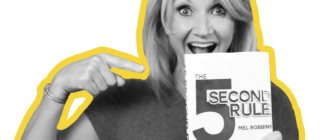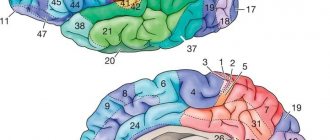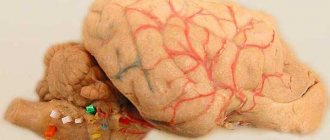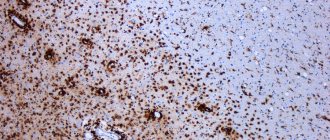Many people have heard that a person only uses 10% of his brain. And these few percentages are enough for the development of information technology, medicines, space exploration and much more. Imagine how life will change if a person starts using his brain to the maximum. But are we really using only a small part of our resources? Let's find out in this article.
Take free logic, idea generation, memory and critical thinking tests now to see how well you use your brain.
Refutation of the theory
Modern scientists, in particular, neuroscientist B. Gordon, have provided several arguments that completely refute the myth of 10% brain use. These include:
- During natural selection and the passage of stages of evolution, only the characteristics that were significant for a particular species were selected. If 90% of the brain did not perform any functions, then, accordingly, in the process of evolution, these parts of the central nervous system would disappear.
- Modern research methods, that is, various scans, make it possible to determine the absence of blind spots in brain activity. The appearance of inactive areas is observed only in individuals who have some kind of brain damage.
- It has been experimentally proven that each part of the brain is responsible for a specific function. If a part of the brain is damaged, in any case, some kind of disturbance in central nervous activity will occur.
- It has been proven that every single brain cell is functionally active.
- In the course of research, it turned out that non-use of any part of the human body (part of an organ or even a limb) leads to its atrophy, and in some cases to replacement with connective tissue. If there were inactive areas in the brain, they would atrophy or degenerate.
You've suspected it for a long time: people use their brains 100%
Many people share the misconception that only 10% of the human brain works, while the remaining 90% remains unused. This is actually a myth. Our brain is an extremely efficient computing machine with an already developed energy-saving plan. American neuroscientist Richard Saitovich talks about this at the TED conference.
A common myth states that we only use 10% of our brain - the remaining 90% of capacity is idle.
Various charlatans in their books and methods promise to unlock the untapped potential of the brain with the help of neuroscience - in fact, it’s all a hoax. Two-thirds of all people and just over half of all teachers in the world believe this myth. In the 1890s, William James, the father of American psychology, said, “Most of us do not use our mental potential.” By these words he meant challenging our abilities, not limiting them, but the most popular misinterpretation of his words has become. It was reinforced by the fact that for a long time scientists could not understand the significance of the large, frontal and parietal lobes of the brain. Their injuries did not cause motor or sensory disturbances, so it was believed that they did nothing. For decades, these parts were called “quiet zones.” We now know that they are responsible for rational thinking, planning, decision making and adaptation.
“If most neurons were not used, evolution would have gotten rid of unnecessary brain volume long ago.”
The idea that 90% of the brain is idle all the time seems absurd when you consider how much energy it consumes. Rodents and mammals use 5% of their body energy to support the brain, monkeys 10%, adults 20%, with the brain occupying only 2% of their body, children 50%, and infants 60%.
The human brain weighs 1.5 kg, the elephant brain weighs 5 kg, and the whale brain weighs 9 kg. We surpass any other living creature in the number of neural connections. This requires a lot of energy, which we can obtain to great advantage thanks to the invention of cooking. Food comes to us already prepared for digestion, so we can afford to maintain a brain with 86 billion neurons - 40% more than that of monkeys.
If all the neurons in at least one part of the brain worked simultaneously, the overall energy load would be unbearable. Therefore, only small areas of neurons are simultaneously activated in the brain, which are constantly replaced - this is called the sparse coding method. It allows you to spend a minimum of energy while processing maximum information - from one to 16% of neurons are used at a time. A person is bad at multitasking - we simply don’t have enough energy to keep everything under control - as a result, we do each task worse than individually. If most neurons were not used, evolution would have long ago gotten rid of unnecessary brain volume.
You can learn more about what percentage of the brain we use in this TED video.
Where did the myth about 10% brain activity come from?
The statement about 10% of brain activity appeared quite a long time ago; many different psychologists, philosophers and scientists supported the idea. This idea was developed in their works by both Dale Carnegie and William James. The idea of human superpowers sounds tempting; I want to believe in the strength and energy of humanity. Perhaps this myth arose due to misinterpretation of research. When imaging the brain, it was found that during activity only part of the brain area was highlighted, the rest of the area seemed to be gray. These gray areas were considered “non-working”. Today, scientists explain that a bright spot in an area of the brain means increased activity, while a less pronounced area is used to a lesser extent.
Take online courses for free and discover new opportunities Start studying
This all seems to sound right, but...
Many authors on their websites describe the brain as a tool, a computer that can easily be programmed to be positive.
They just forget to tell you how to do it. What kind of place do you need to gather and decide to take such a step - to reprogram your brain.
Many books on psychology and psychotraining have been written that talk about the need to think “correctly,” but no one says where to get the strength to start thinking like that.
If a person is depressed, or mired in envy, or is stifled by hatred, or is tormented by jealousy... from what source will the strength and desire to reprogram the brain to be positive come from? How to shut up jealousy, which draws pictures of betrayal, or revenge, which builds thoughts about how to take more painful revenge?
After all, even the most intelligent and logical people are susceptible to negative feelings, emotions and thoughts and, despite the good structuring of their mind, logical thinking and intelligence, cannot cope with them. The authors provide no explanation for this.
Yes, these 5 points described above really make it possible to switch gears and take a break from the negative. Only this negativity does not disappear into nowhere, but waits for its moment. After all, childhood grievances and disappointments are remembered with pain even in old age, despite the passage of time (vacation, rest, adventures, positive moments, etc.).
When a person is tormented by “sick” thoughts, it is very difficult to think positively. You can play “I think positively” on the outside, but inside the cats are still scratching. And vice versa, if a person feels good at heart, then everything around him seems wonderful.
After all, if we could so easily reprogram our brains, as many authors claim, would we choose to suffer? Would we voluntarily suffer, tormented by thoughts of resentment and hatred, thoughts of treason and betrayal, illness and death? We would all voluntarily choose to think positively, because it is both pleasant and healthy.
To change your thinking and program yourself to be positive, you need to “treat” your inner world (your soul).
Brain nutrition
The brain spends the lion's share of the resources received in one day. So, for daily self-care at rest (let’s assume that this is a normal day in “light” mode, without physical activity and costly intellectual activity), the brain will spend 250 kcal. If a person turns on the increased difficulty mode, the brain will take the required 750-1000 calories from the daily calorie intake. Now imagine that a person on a diet with a caloric intake of 1300-1500 will simply collapse at the end of the day, even in “light” mode. After all, in order to go to work every day, manage the baby at home, engage in physical labor, pump up the abs, prepare food, consume and digest, the body requires a minimum of 2000 kcal, not counting the cost of maintaining the brain +500 kcal on average. You will definitely be able to lose weight quickly. But there is no need to say that a person with a limited diet will successfully overcome everyday stressful situations and loads and achieve good results in the professional field or in sports.
Misconceptions of People
Research results show that 65% of people surveyed believe this myth is true; and 5% think this number is increasing due to their belief in evolution.
Even the TV show MythBusters a few years ago wrongly corrected the myth of 10% of the brain being used by 35%.
Like most legends, the origins of this fiction are unclear, although there is some speculation. The origins come from neuroscientist Sam Wang
(Sam Van) of Princeton, author of "Welcome to Your Brain."
It may have been William James
(William James), who was considered one of the most influential thinkers in psychology at the beginning of the 20th century. He said: “People have untapped intellectual potential.”
This quite reasonable statement was later revived in distorted form by the writer Lowell Thomas
(Lowell Thomas) in 1936 in his introduction to the book How to Win Friends and Influence People.
“Professor William James of Harvard said that the average person develops only 10 percent of his latent psychic ability,” writes Thomas. It looks like he or someone else at one time just mentioned a number he liked.
The 10% statement is clearly false.
for several reasons.
Result:
- The entire brain works (if you are healthy), but there is a huge scope for activity in terms of increasing its productivity.
- The brain has enormous potential and an exciting future lies ahead.
- The less we use something, the faster we will forget how to do it.
- Under living conditions, the brain uses more neurons than in a strictly rule-bound game, such as Go or chess.
Well! Increase efficiency, learn. Remember that it is much easier to restore knowledge than to create new ones, so do not be afraid to weaken old neural connections.
How does the human brain really work?
The human brain is a complex organ, and contains billions of neurons for a reason. The fact is that neurons from different parts of the brain have completely different tasks and functions. For example, when you listen to music, the neutrons responsible for hearing are activated. When you are happy or sad, the neurons responsible for emotions come into play. And even when you just put your hand on the table, feeling the wooden surface under your fingers, the brain works: information comes from the senses, the neurons that are responsible for their work are activated.
How much a person’s brain works is determined only by the number of actions it performs at a time, that is, the load on neurons. Perhaps at some moments a person actually uses only 10 percent of his brain, but simply because more is not needed: he is resting or doing nothing.
And yet, is it possible to improve brain function?
Of course you can! Just don’t try to use your brain 100%, it’s ineffective and impossible. Improved brain function means good memory, increased productivity, more effective learning and mastering new information. Neurons are responsible for all these functions, or more precisely, neural connections necessary for the normal functioning of the human body. They are formed throughout life, and right now you can contribute to their more active formation. To be an intelligent and well-rounded person, you don't have to worry about how much the human brain is used. You just need to train it regularly. It's almost like exercising your body. You can find various courses and workouts that can improve brain function on BrainApps.
Who said that the BRAIN and 100% trust in it is the crown of human life?
This was said by the person who proved to others that he is part of the animal world (the monkey is the theory of the origin of man).
If you conditionally put your brain aside and pay attention to your soul, you can discover and realize how the soul (feelings and emotions) controls the brain (computer), manifesting actions in reality, and not vice versa.
Is it possible to determine why the brain of one of the twins works correctly, while the other has disorders in... the brain? What if this disorder is not in the brain, but in consciousness, which exhibits brain activity?
But in order to understand this mechanism, one must recognize that the soul is a real reality that is closed to many minds that recognize facts only through physical eyes and ears.
What is known from scientists' research?
Scientists have repeatedly conducted studies of the human brain and are still studying this organ. Using an MRI machine, scientists were able to visualize the brain and study its active and inactive areas. According to research, not the entire brain is responsible for our actions and processes, but only certain areas. For example, one area is responsible for vision, a completely different one for hearing, a third for speech, etc. Throughout the day, we use almost all areas of the brain. Even to scroll through a feed on social networks, we activate several areas at once - the area of vision, understanding and action. Scientists say that at the moment they have not been able to identify a single inactive part of the brain.










